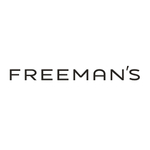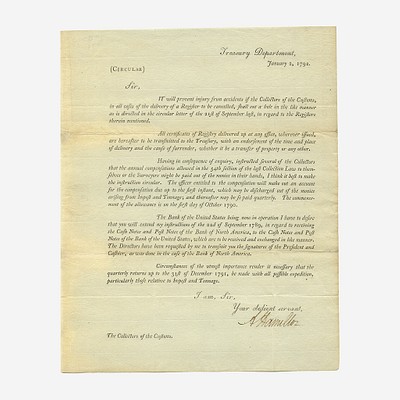[Hamilton, Alexander] [United States Mint] An Ordinance for the Establishment of the Mint of the United States of America; and for Regulating the Valu
About Seller
2400 Market St
Philadelphia, PA 19147
United States
Established in 1805, Freeman’s Auction House holds tradition close, with a progressive mind-set towards marketing and promotion, along with access to a team of top experts in the auction business. And now with offices in New England, the Southeast, and on the West Coast, it has never been easier to ...Read more
Two ways to bid:
- Leave a max absentee bid and the platform will bid on your behalf up to your maximum bid during the live auction.
- Bid live during the auction and your bids will be submitted real-time to the auctioneer.
Bid Increments
| Price | Bid Increment |
|---|---|
| $0 | $25 |
| $500 | $50 |
| $1,000 | $100 |
| $2,000 | $200 |
| $3,000 | $250 |
| $5,000 | $500 |
| $10,000 | $1,000 |
| $20,000 | $2,000 |
| $30,000 | $2,500 |
| $50,000 | $5,000 |
| $100,000 | $10,000 |
About Auction
Oct 25, 2021
Freeman's is honored to present The Alexander Hamilton Collection of John E. Herzog, a single-owner sale of Alexander Hamilton material, on October 25. Curated by Darren Winston, Head of the Books and Manuscripts Department. Freeman's info@freemansauction.com
- Lot Description
[Hamilton, Alexander] [United States Mint] An Ordinance for the Establishment of the Mint of the United States of America; and for Regulating the Value and Alloy of Coin
Rare printed ordinance for the establishment of a United States Mint
[Hamilton, Alexander] [United States Mint] An Ordinance for the Establishment of the Mint of the United States of America; and for Regulating the Value and Alloy of CoinRare printed ordinance establishing the United States Mint
(New York, 1786). Bifolium sheet, 12 3/4 x 7 1/2 in. (324 x 190). Printed broadside. Creasing from original folds; lightly toned. A fine example. Evans 20074; Sabin 57509; Streeter Sale 1042
Debates surrounding the establishment of a central mint can be traced back to 1777 when Congress advised the Treasury Board to look into the matter. At the time no action was taken, and with the passage of the Articles of Confederation in 1781, states were granted the authority to strike their own coin. By 1782, with Robert Morris acting as Superintendent of Finance, charged with the goal of rescuing the U.S.'s finances, he requested from Congress the authority to establish a mint. He was likely inspired by a letter the previous spring from Alexander Hamilton, who painstakingly detailed his vision of establishing public credit and a national bank. The establishment of a mint was also on Hamilton's agenda as he wrote in article 10 of his letter, "...the power of coining to the amount of half its stock, the quantity of alloy &c. being determined by Congress…" By the fall of 1786 the Board of Treasury submitted the above Ordinance to the Continental Congress, and it was immediately authorized. The ordinance provides for a Master Coiner, fixes the value of silver and gold, and outlines other provisions for the operation of the mint. It would take until 1792, under the guidance of Hamilton as the first Secretary of the Treasury, before Congress passed the Coinage Act, establishing the mint as well as the U.S. dollar. The first Mint was founded in Philadelphia, then the nation's capital, in 1792, and began operations in 1793 under the directorship of renowned scientist David Rittenhouse. It was the first building of the Republic erected under the Constitution.
As a previous cataloguer writes about the location of the printing of this document, "Evans originally ascribed the place of publication to New York, though NAIP cites Ford's bibliographic notes on the issues of the Continental Congress in ascribing it to John Dunlap's press in Philadelphia." The Congress of Confederation moved to New York City in 1785 when it became the capital. Rare.
Footnote:The ordinance as reported in Congress Sept. 20, 1786. Cf. Journals of the Continental Congress, v. 31, p. 682-685
- Shipping Info
-
No lot may be removed from Freeman’s premises until the buyer has paid in full the purchase price therefor including Buyer’s Premium or has satisfied such terms that Freeman’s, in its sole discretion, shall require. Subject to the foregoing, all Property shall be paid for and removed by the buyer at his/ her expense within ten (10) days of sale and, if not so removed, may be sold by Freeman’s, or sent by Freeman’s to a third-party storage facility, at the sole risk and charge of the buyer(s), and Freeman’s may prohibit the buyer from participating, directly or indirectly, as a bidder or buyer in any future sale or sales. In addition to other remedies available to Freeman’s by law, Freeman’s reserves the right to impose a late charge of 1.5% per month of the total purchase price on any balance remaining ten (10) days after the day of sale. If Property is not removed by the buyer within ten (10) days, a handling charge of 2% of the total purchase price per month from the tenth day after the sale until removal by the buyer shall be payable to Freeman’s by the buyer. Freeman’s will not be responsible for any loss, damage, theft, or otherwise responsible for any goods left in Freeman’s possession after ten (10) days. If the foregoing conditions or any applicable provisions of law are not complied with, in addition to other remedies available to Freeman’s and the Consignor (including without limitation the right to hold the buyer(s) liable for the bid price) Freeman’s, at its option, may either cancel the sale, retaining as liquidated damages all payments made by the buyer(s), or resell the property. In such event, the buyer(s) shall remain liable for any deficiency in the original purchase price and will also be responsible for all costs, including warehousing, the expense of the ultimate sale, and Freeman’s commission at its regular rates together with all related and incidental charges, including legal fees. Payment is a precondition to removal. Payment shall be by cash, certified check or similar bank draft, or any other method approved by Freeman’s. Checks will not be deemed to constitute payment until cleared. Any exceptions must be made upon Freeman’s written approval of credit prior to sale. In addition, a defaulting buyer will be deemed to have granted and assigned to Freeman’s, a continuing security interest of first priority in any property or money of, or owing to such buyer in Freeman’ possession, and Freeman’s may retain and apply such property or money as collateral security for the obligations due to Freeman’s. Freeman’s shall have all of the rights accorded a secured party under the Pennsylvania Uniform Commercial Code.
-
- Buyer's Premium



 EUR
EUR CAD
CAD AUD
AUD GBP
GBP MXN
MXN HKD
HKD CNY
CNY MYR
MYR SEK
SEK SGD
SGD CHF
CHF THB
THB![[Hamilton, Alexander] [United States Mint] An Ordinance for the Establishment of the Mint of the United States of America; and for Regulating the Valu](https://s1.img.bidsquare.com/item/l/9470/9470996.jpeg?t=1MwoEV)
![[Hamilton, Alexander] [United States Mint] An Ordinance for the Establishment of the Mint of the United States of America; and for Regulating the Valu](https://s1.img.bidsquare.com/item/s/9470/9470996.jpeg?t=1MwoEV)










